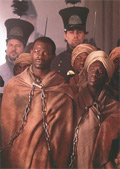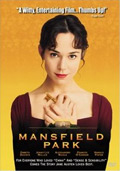You are here: Reports » Phase 1: media » Analysis » Representation equals recognition?...
Representation equals recognition? The portrayal of slavery on screen: from Roots to Amistad, Mansfield Park and Amazing Grace
Ross Wilson (University of York)
The representation of slavery and abolition in film is not only a highly emotive and potentially divisive subject it also provides a means of accessing the past in a manner which is empowering and rewarding. Representations of historical contexts on film and television have often proven to be very important in the creation of public memory. Indeed, these cultural modes of expression are often critically considered to be amongst the main source of people's perceptions and memories of the historic past.
Rather than assuming the popular memory of enslavement is the result of the passive public consumption of cultural forms, this project takes the position that certain tactics are used in the acceptance and denial of forms of memory (after de Certeau 1984: 18). Media representations are an ideal form in which to demonstrate this process of the construction of memory (see Hoskins 2001). Film and television programmes are also often seen by cultural critics as vehicles to appropriate, disseminate and control popular memory by a dominant group. This assertion however rests on the unacknowledged assumption that viewers have no role to play in the dissemination of beliefs and values through film and television (after Foucault 1975: 25). These cultural forms however provide a means by which consumers can articulate possible dissident and resisting memories (after Fiske 1987). This emphasises a reciprocal role in the consumption and production of media, as producers respond to the tastes and desires of their audiences. Popular culture in this respect is a conduit for popular memory, which whilst supplying certain forms and images to a viewing public, represents an opportunity of allowing individuals to choose representations of the past for themselves (Brabazon 2005: 67). Through the study of the representation of one television miniseries and three major films this article will assess the 'media memories' of the transatlantic slave trade. This will focus on the use of particular scenes and images which are used by producers to convey particular memories of the past and are in turn accepted or rejected by their audience.
The television series Roots (1977) has had a dramatic impact upon the perception of enslavement and the representation of slavery. Based on the bestselling novel by Alex Haley, the series follows the 'saga of an American family.' Beginning with the capture and enslavement of the initial protagonist Kunte Kinte in The Gambia in the mid eighteenth century, the programme charts the live of Kunte and his family to the end of the American Civil War. What was significant about Roots was that for the first time viewers were shown the brutality of enslavement, the lack of representation for the enslaved, and the legacy of racism that blights post-emancipation societies. Significantly Roots also depicted the strength which enabled the resistance to oppression. The series contains some very powerful scenes; of capture; enslavement; the Middle Passage; punishment on the labour camps of the plantation; Kunte's capture and struggle as the manacles are placed onto his wrists; the Middle Passage; the rape of enslaved women; the holds of the ships with chains and shackles imprisoning the enslaved; the whipping of Kunte for his attempt at escape; the rape of Kizzy, Kunte's daughter, by the man to whom she was sold. These scenes had a dramatic effect on the audience evidenced by viewing figures of nearly 19 million people in Britain. Significantly these scenes also set the agenda by which slavery has been remembered in Britain.

A scene from Roots
Copyright: David L. Wolper Productions
It is through Roots that popular memory for certain generations has been formed and it is through Roots that subsequent portrayals of enslavement have been constructed. Audience surveys conducted at Liverpool's new International Museum of Slavery in August 2007 revealed the ingrained perception of the series, as interviewees would often cite Roots as being their impression of slavery. The programme was praised for its 'realism' and the fact that it 'told the truth.' The series appeared to have struck a chord with its audience and generated public approval for this mode of representation. It was a history that apparently found favour with an audience in Britain that both connected to the African Diaspora and those that did not. Particular scenes and themes have been reused by subsequent films and television programmes as the 'Roots version of history' was seen by producers as the accepted version of history. The reason for this acceptance can be located in the presumption of the 'realistic' nature of the portrayal of the history of enslavement in Roots (after Comolli and Narboni 1971). Viewers believed that this is what history was 'really like' (Fiske 1987: 21). The manner in which these scenes have been recycled in subsequent programmes though is evident of the tastes, desires and needs of society at a particular moment in time. The notion of 'realism' is certainly not static, and what constitutes 'the real' is continually changing phenomenon, based more upon the social context of consumption. This assessment also significantly highlights the difference of consumption in Britain and in America. In Britain, Roots was a history that had occurred elsewhere. Whilst it spoke to many black people in Britain of their heritage, for non-black people it served contradictorily to show both the brutality of slavery but also its absence. In the context of the increasingly fractious British society with 'race riots' in the 1970s and 1980s, Roots served to show for many in Britain that the issue and damaging legacy of slavery was a problem which was derived from another country.

A scene from Amistad
Copyright: Dreamworks
The 1997 film Amistad is also particularly evident of this difference in consumption. The film drew heavily upon the Roots television series. Indeed, the scenes of rebellion onboard the slave ship is highly reminiscent of the uprising that takes place on the slave ship in the television programme. This connection is stated to draw viewers into a discourse they are already aware of and which has already found favour. The scenes of the Middle Passage in Amistad also utilise the visual representation set in place by Roots. The sight of chained bodies struggling in the ship's hold recalls the passage of Kunte as he underwent the torturous route across the Atlantic. Significantly even the camera angle is positioned in the same way, offering the audience not the viewpoint from the sailors of the slave ship but from the angle of the enslaved themselves, the audience is asked to view the action from the perspective of those in chains. The 'realism' of the film derives from the audience perception of scenes of brutality and human suffering as accurate portrayals. Where the American audience of Roots had the Civil Rights Movement of the 1950s and 1960s to interpret the oppression, both British and American audiences in the 1990s had different sources in which to understand the scenes in Amistad. Whereas in America slavery was shown to be a state-sanctioned institution, in Britain the portrayal of slavery is seen as a specific problem for America. A mature British presence in the form of a captain from the Royal Navy Squadrons, which patrolled the east coast of Africa to halt slave ships, is understood in contrast to American slavery. The film portrays British abolitionism and humanitarianism in contrast to the slave-supporting southern states of America. This attitude of consumption reinforces the detached perception in Britain, as Amistad acted to reinforce the memory of slavery in Britain as an 'American issue.'

The poster for Mansfield Park
Copyright: MGM
Mansfield Park and Amazing Grace similarly draw on the Roots version of history, though to a substantially different effect, evident of the tastes and desires of sections of the British public. Mansfield Park focuses not on the treatment of the enslaved but on the crimes of those involved in the trade. Placing itself as a 'post-colonial' reinterpretation of Jane Austen's novel, the film departs from the book by portraying Sir Thomas Bertram as a rapist on his plantation in Antigua. Whilst the scenes of rape and sexual exploitation of women in Roots provided a means of witnessing the oppressive institution of plantation slavery, within Mansfield Park it serves merely to inform us of the character of Sir Thomas. This is certainly not a cry for recognition for those who have suffered it is means of further obscuring and perpetuating notions of exclusion. These scenes are included not because they would have been impossible to exclude given the nature of contemporary society, rather because they serve to reinforce a particular British memory of the slave trade: of its occurrence in another place by other people. This theme is continued in the recent British film Amazing Grace, which portrays the work of the abolitionist William Wilberforce. The figure of the manacled enslaved individual which appears to Wilberforce is shown not as an image of empowerment, as witnessed with Kunte Kinte, but one which is designed to evoke pity and thereby support for the efforts of Wilberforce. The scenes in Amazing Grace on a slave ship are similar to Roots, but the enslaved are entirely absent. The camera angle pans between the shackles at head-height so we witness Wilberforce's shock and disgust at the conditions. The audience is asked to experience the slave ship from the view of the abolitionist. The scenes are comparable to Roots but entirely different in their effect and purpose. This is a 'media memory' for those not willing to engage in what some may consider to be the potentially disturbing past of African empowerment and representation.

A scene from Amazing Grace
Copyright: Walden Media
Describing how Roots has set the agenda for the visual representation of enslavement draws a number of issues to the fore. The perception of Roots in Britain as an accurate example of enslavement enables the consideration of the brutalisation of others. It does not however enable the means of considering the transatlantic slave trade as a 'British institution.' The audience reception surveys, which cited Roots as influential in the perception of enslavement, are significant as they reveal a certain form of consumption of 'media memories.' The importance of Roots in the formation of popular memory is that it gave representation to those who had been excluded. The consumption in Britain of Roots, and subsequent portrayals of slavery in film and television, has however ensured that recognition of Britain's complicity in the slave trade is not represented. The memory of slavery as a crime committed by others, in another place, is the result of tactically reinterpreting 'media memories' by sections of the audience to suit the current nature of society.
Bibliography
- Amazing Grace (2007) Directed by Apted, M. Film. UK/USA. Walden Media. Amistad (1997) Directed by Spielberg, S. Film. USA. Dreamworks SKG.
- Brabazon, T. (2005) From Revolution to Revelation: generation X, popular memory and cultural studies. Aldershot. Ashgate.
- de Certeau, M. (1984) The Practise of Everyday Life. Trans. S. Rendall. Berkley. University of California Press.
- Comolli, J-L. and Narboni, P. 1971. Cinema/ideology/criticism. Screen 12, 27-36.
- Fiske, J. (1987) Television Culture. London and New York. Routledge.
- Foucault, M. (1975) Film and Popular Memory: An Interview with Michel Foucault. Radical Philosophy 11, 24-29.
- Hoskins, A. (2001) New Memory: mediating history. Historical Journal of Film, Radio and Television, Vol.21(4), 333-346.
- Mansfield Park (1999) Directed by Rozema, P. Film. UK. Arts Council of England.
- Roots (1977) Directed by M. Chomsky and J. Erman. Television. USA. David L. Wolper Productions.
